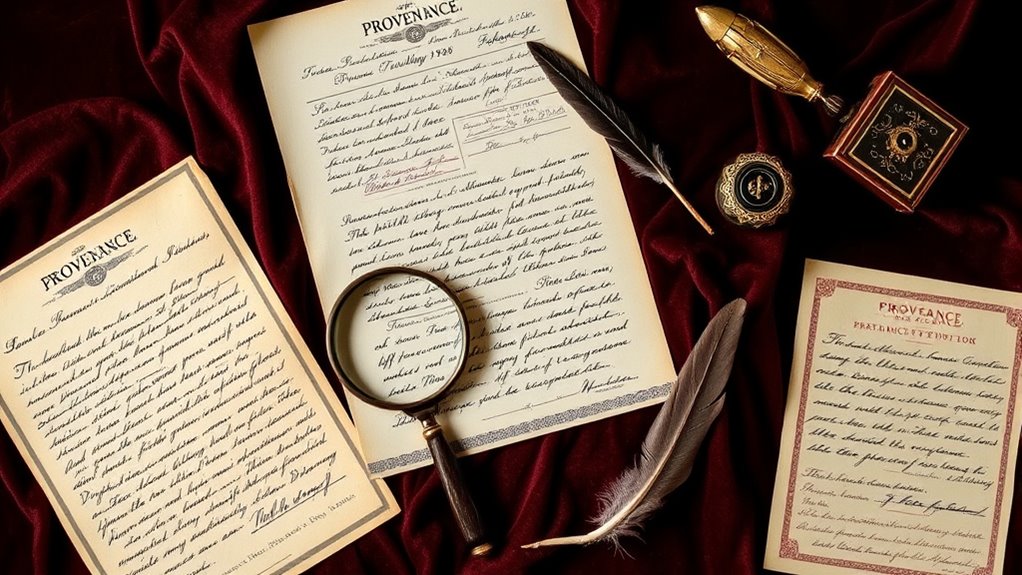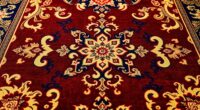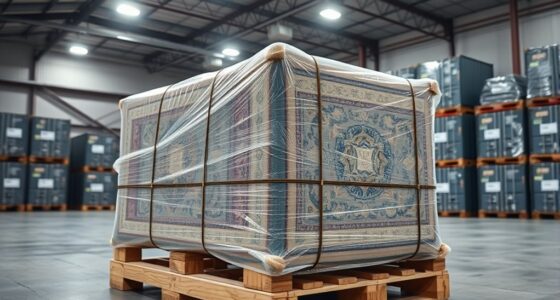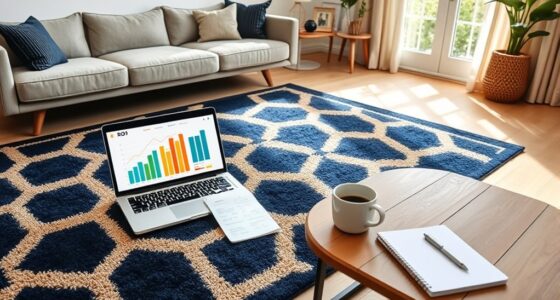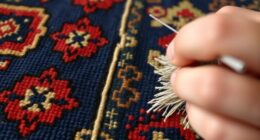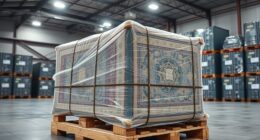To master rug provenance papers for resale, focus on verifying authenticity through detailed documentation like certificates, ownership histories, and expert appraisals. Examine dye tests, knot counts, and weaving techniques to confirm origin and age. Cross-check all details using databases and expert resources, ensuring consistency. Organize your documents clearly to build trust with buyers. If you want to confidently authenticate, evaluate value, and present your rugs effectively, exploring proven techniques further will give you the edge.
Key Takeaways
- Understand the significance of provenance in establishing rug authenticity, origin, and value for confident resale.
- Familiarize yourself with essential documents like certificates, ownership records, and appraisal reports.
- Cross-check provenance details with technical analyses such as dye testing, fabric verification, and motif interpretation.
- Verify authenticity through consistent documentation, expert appraisals, and technical testing to prevent disputes.
- Present organized provenance records clearly to buyers, emphasizing authenticity, history, and care to boost trust.
Understanding the Importance of Provenance in Rug Reselling

Understanding the importance of provenance in rug reselling is essential because it directly impacts a rug’s value and buyer confidence. Provenance reveals details about a rug’s origin, including weaving techniques that indicate regional craftsmanship and authenticity. By analyzing weaving techniques, you can verify if the rug matches its claimed origin, boosting credibility. Dye analysis also plays a vital role, helping you identify natural dyes and their age, which adds to the rug’s provenance. When you understand these aspects, you can better assess a rug’s authenticity and worth. Additionally, smart inspection methods allow for more precise verification of a rug’s provenance using modern technology. This knowledge not only helps you price rugs accurately but also reassures buyers about their purchase. In essence, grasping provenance’s role ensures you make informed decisions and build trust in the resale market.
Common Types of Rug Provenance Documents
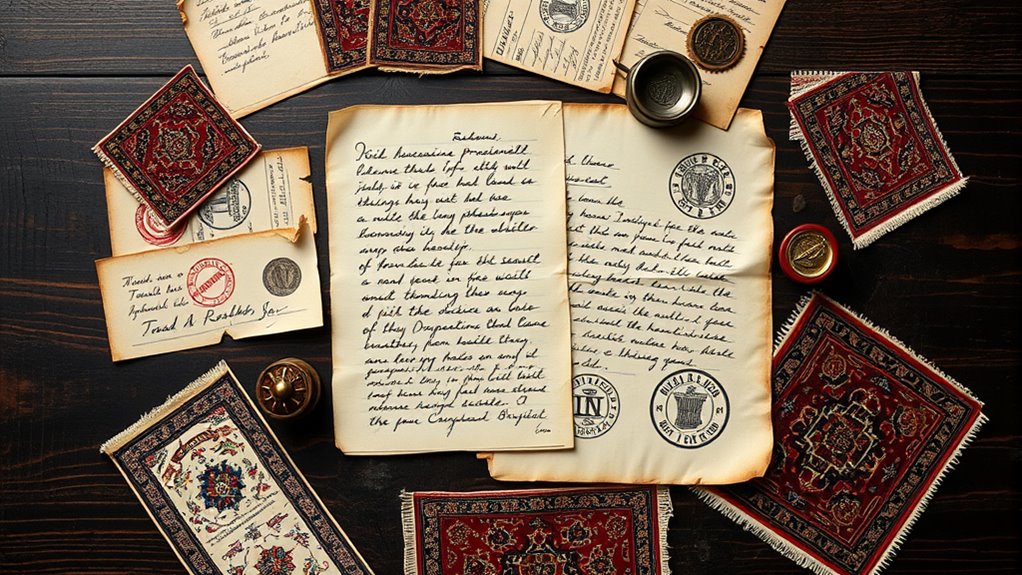
You’ll encounter several key documents that establish a rug’s provenance, starting with authenticity certifications that confirm its origin. Ownership records track the rug’s history of ownership, while appraisal reports provide an expert valuation. Understanding these documents helps you verify a rug’s legitimacy and value with confidence.
Authenticity Certification
Authenticity certification plays a essential role in verifying the provenance of a rug, providing assurance of its origin and quality. This document confirms the rug’s authenticity, often issued by experts or reputable organizations specializing in textile preservation and antique restoration. Such certifications detail the rug’s age, origin, and craftsmanship, helping you establish trust with buyers. They often include photographs and expert appraisals, which validate the rug’s value. When resale arises, these certifications reassure buyers that they’re investing in a genuine piece, not a reproduction. Keep in mind, authentic certificates are indispensable for high-value antique rugs, as they support claims of provenance and condition. Additionally, color accuracy in photographs is crucial to accurately represent the rug’s true hues, further enhancing buyer confidence. By obtaining and understanding these documents, you solidify your position in the market and ensure confidence in your resale transactions.
Ownership Documentation
Ownership documentation provides tangible proof of a rug’s history and chain of custody, confirming its journey from maker to current owner. These documents often include details like fiber composition, which reveals the materials used, and dye analysis, which can help authenticate the rug’s origin. Understanding these records guarantees you’re aware of the rug’s provenance and value. Additionally, sound healing science suggests that authenticating a rug’s origin through detailed analysis can enhance its cultural and historical significance, thereby potentially increasing its resale value.
Appraisal Records
What types of appraisal records serve as key documentation for establishing a rug’s provenance? Restoration records and repair histories are essential. Restoration records detail any work done to preserve or enhance the rug, providing insight into its condition and authenticity. Repair histories reveal past damages and how they were addressed, helping you understand the rug’s durability and care over time. These records often include invoices, detailed descriptions, and photographs, making them valuable for verifying origin and value. When reselling, having extensive appraisal records can boost buyer confidence, demonstrating transparency about the rug’s history. Accurate documentation of restoration and repair work ensures you present a clear, trustworthy provenance, ultimately supporting a successful resale.
Key Elements to Look for in Provenance Papers
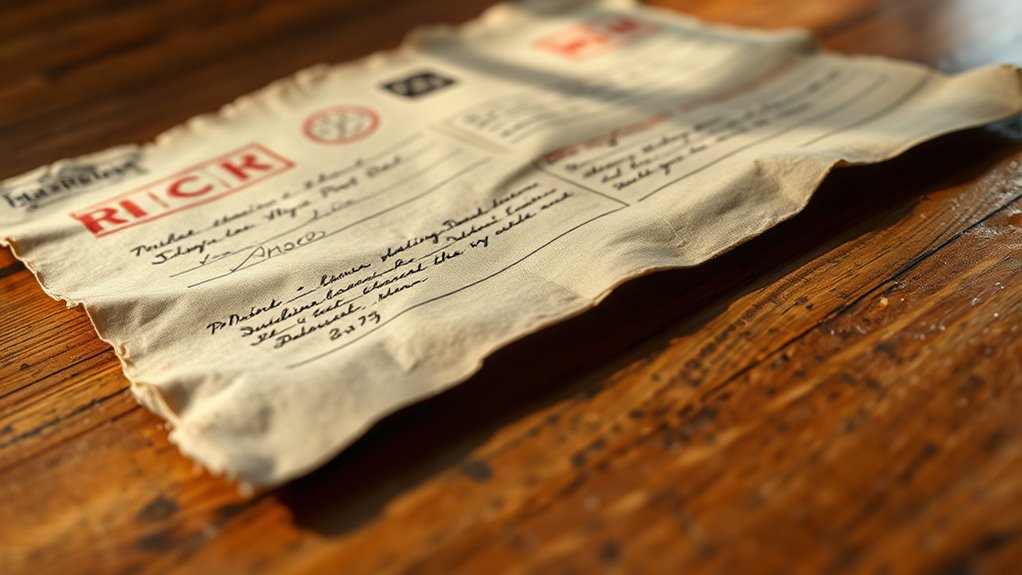
When examining provenance papers, focus on authenticity certifications and stamps that verify the rug’s origin. Look for detailed records of ownership and history to establish a clear provenance. These elements help guarantee you’re investing in a genuine piece with a verified background. Ensuring proper documentation is in place can also help prevent issues related to disputed ownership or authenticity.
Authenticity Certifications and Stamps
Authenticity certifications and stamps serve as essential indicators of a rug’s provenance, providing tangible proof of its origin and history. They verify authenticity and can reveal details about the rug’s age, region, and craftsmanship. When examining these stamps, look for official seals, signatures, or labels from recognized authorities or appraisers. These markings often include information relevant to color analysis, showing whether the dyes used are natural or synthetic. Additionally, provenance papers may mention rug cleaning techniques, indicating proper care history that maintains value. Authentic stamps help protect you from counterfeits and ensure you’re investing in a genuine piece. Always compare stamps with trusted sources to confirm legitimacy and gain confidence in your resale process. Incorporating attention to detail during inspection enhances your ability to identify creative practice signs of authenticity and craftsmanship.
Detailed Ownership and History
Looking closely at provenance papers reveals crucial details about a rug’s ownership and history that can significantly influence its value. You should examine records of restoration history, which indicate past repairs or refurbishments that affect the rug’s condition and authenticity. Material analysis documented in provenance papers can also confirm the rug’s age and origin, helping you assess its authenticity. Analyzing ownership records, such as previous owners or exhibitions, provides insight into the rug’s journey and provenance. These details help you determine if the rug has been well-preserved or altered over time. Additionally, understanding the technological tools used in authentication can further enhance your confidence in verifying the rug’s provenance. By scrutinizing this information, you gain confidence in your appraisal and ensure you’re making an informed resale decision. Accurate ownership and history details are essential for establishing true value and authenticity.
Verifying Authenticity and Detecting Fakes

To accurately verify a rug’s authenticity, you need to carefully examine its provenance papers for specific details and inconsistencies. Check for accurate dye analysis reports, as fake rugs often use synthetic or inconsistent dyes. Confirm the knot count matches the described quality; for example, higher knot counts typically indicate finer craftsmanship. Look for discrepancies in the rug’s origin details, such as incorrect region names or dates. Additionally, review any certificates or signatures for authenticity. Be wary of overly generic or vague descriptions that lack specific data. Review personal finance management strategies to ensure your investments in authentic art or collectibles are secure and well-informed.
The Role of Provenance in Determining Value

Provenance plays a crucial role in determining a rug’s value because it provides a documented history that verifies its origin, craftsmanship, and ownership. When evaluating a rug, you’ll find that fiber quality greatly impacts value; high-quality fibers, like fine wool or silk, elevate the rug’s worth. Provenance can also reveal consistent, well-maintained color over time, which indicates proper dyeing techniques and good preservation, boosting desirability. A well-documented provenance assures buyers of authenticity and quality, making the rug more attractive for resale. Additionally, electric dirt bikes demonstrate the importance of technological provenance, which can similarly influence the perceived value of collectible items. Conversely, gaps or uncertainties in provenance can lower a rug’s value, even if it has exceptional fibers or color. Ultimately, clear provenance helps you confidently determine the rug’s true worth based on its craftsmanship and historical integrity.
Tips for Interpreting Historical and Cultural Contexts

Ever wondered how to uncover the deeper meaning behind a rug’s design? To interpret its historical and cultural contexts, look beyond the motifs and patterns. Understand that the symbols often reflect cultural symbolism, representing beliefs, social status, or regional identity. Recognize the historical significance of certain design elements, which can reveal the rug’s origin or era. Additionally, consulting sources like Vetted – Flat Iron Bike can provide insights into traditional motifs and their meanings within specific cultures.
Key tips include:
- Research traditional motifs and their meanings within specific cultures
- Consider the geographic region and historical period associated with the design
- Consult experts or reference books on cultural symbolism for deeper insight
Strategies for Cross-Checking and Confirming Provenance

Once you’ve identified potential cultural symbols and historical details, verifying the rug’s provenance requires careful cross-checking. Start with fabric analysis to determine material authenticity and age, comparing findings with known regional textiles. Dye testing is also essential; by analyzing dye composition, you can confirm whether the colors align with the supposed origin and time period. Cross-reference your results with reputable databases, auction records, and expert catalogs. Look for consistency between the physical characteristics and documented provenance. If discrepancies arise, investigate further through additional testing or expert consultation. Incorporating lifestyle considerations, such as the environment in which the rug has been kept, can provide additional context and aid in verification. Combining fabric analysis and dye testing helps you build a solid case for the rug’s authenticity, reducing the risk of misrepresentation and ensuring your provenance claims are accurate and credible.
Building a Reliable Documentation Portfolio
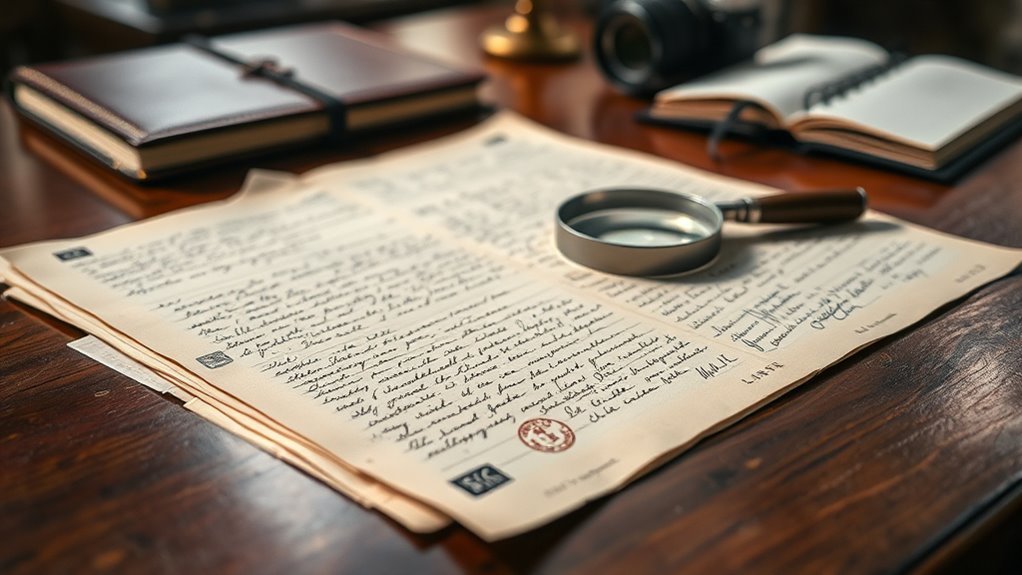
How can you verify your rug’s provenance documentation is trustworthy and complete? Building a reliable documentation portfolio starts with thorough research into rug weaving history and proper color symbolism. You want evidence that confirms authenticity and origin.
To do this effectively, consider these steps:
- Collect detailed records of rug weaving techniques, including regional styles and signature patterns.
- Gather expert appraisals and certificates from reputable sources.
- Document the significance of colors used, understanding their cultural symbolism and how they relate to the rug’s origin.
A solid portfolio combines technical details with cultural insights, ensuring buyers see the rug’s true value. Accurate documentation not only boosts confidence but also preserves the rug’s provenance and enhances resale potential.
Best Practices for Presenting Provenance to Buyers
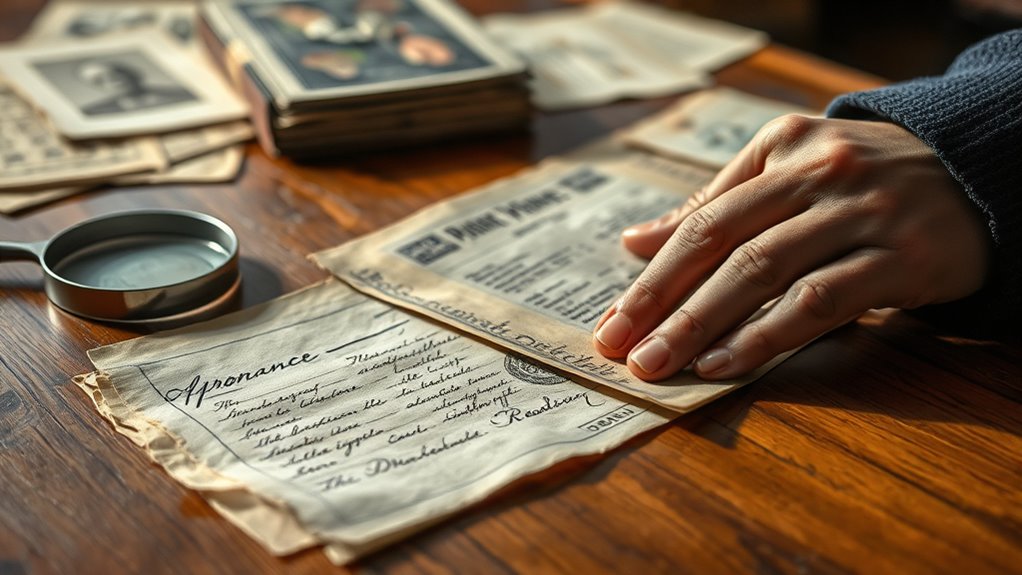
Presenting your rug’s provenance effectively can markedly influence a buyer’s confidence and decision-making. Start by organizing key documents like restoration records to highlight any repairs or restorations, demonstrating transparency. Clearly display shipping details to provide a complete history of the rug’s journey, emphasizing proper handling and care. Use a logical sequence when presenting your provenance, integrating restoration records alongside original documentation to establish authenticity. Be ready to answer questions about repairs, origins, and previous ownership, supporting your claims with documentation. Present everything professionally, whether through a printed packet or digital format, ensuring clarity and easy access. When buyers see detailed, well-organized provenance information, including shipping details and restoration records, they’re more likely to trust the value and authenticity of your rug.
Frequently Asked Questions
How Can I Access Rare or Undocumented Provenance Records?
To access rare or undocumented provenance records, start by exploring digital archives that specialize in rug history and provenance. These online resources often hold valuable, hard-to-find documents. Additionally, consult with experts in antique rugs and textiles, as they can offer insights or direct you to sources you might miss on your own. Combining digital archives with expert consultations greatly enhances your chances of uncovering rare provenance information.
What Legal Considerations Exist When Verifying Provenance Documents?
Verifying provenance documents is like steering through a maze—you need to stay on the right path. You must guarantee authenticity verification aligns with legal compliance, avoiding issues like fraud or misrepresentation. Confirm that records are genuine, properly documented, and legally obtained. Always stay updated on laws governing provenance, as mishandling can lead to legal penalties. By doing so, you protect yourself and maintain trust in your resale practices.
How Does Provenance Influence the Insurance Valuation Process?
Provenance substantially influences the insurance valuation process because it helps guarantee appraisal accuracy and authenticity verification. When you confirm a rug’s history, you can better determine its true value, reducing the risk of over- or under-insurance. This detailed provenance provides insurers with confidence in the rug’s authenticity, streamlining claims and ensuring you receive appropriate coverage. Ultimately, thorough provenance verification helps protect your investment and supports accurate insurance assessments.
Are There Specific Certifications for Authentic Provenance Papers?
You wonder if there are specific certifications for authentic provenance papers. While certification standards vary, reputable organizations like the Global Authenticity Certification Network set strict criteria for verifying authenticity. These standards ensure provenance papers are genuine, providing confidence to buyers and sellers. Authenticity verification becomes more reliable with recognized certifications, establishing trust and supporting the rug’s value. This process helps you confidently confirm the provenance before resale or appraisal.
How Often Should Provenance Records Be Updated or Reviewed?
You should review your provenance records regularly, ideally every 1 to 3 years, to make certain they stay accurate and current. The record updating frequency depends on the rug’s age, condition, and market changes. Establishing a clear provenance review schedule helps you spot discrepancies early, maintain documentation integrity, and support resale value. Staying proactive in updating your records safeguards your investment and enhances trust with potential buyers.
Conclusion
Mastering rug provenance is essential if you want to succeed in reselling. Did you know that rugs with clear provenance can sell for up to 50% more? By understanding key documents, verifying authenticity, and confidently presenting this history to buyers, you boost trust and value. Keep honing your skills, stay diligent with cross-checking, and build a solid provenance portfolio. Your expertise not only enhances your reputation but also maximizes your profits in the vibrant rug market.
